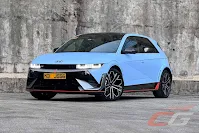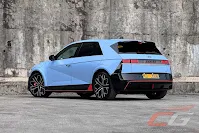It’s a bit silly, but somehow, it’s a given that sporty cars have to have a bit of emotional appeal. Almost anyone can make a 500-horsepower-plus car these days, but it takes the right x-factor to dial in everything else to make sure it tugs on you in the right way. Down one sensory experience—EVs don’t have the mechanical rawness of internal combustion engines—it takes even more effort to transform an EV into something enthusiasts would salivate over. It’s one challenge Hyundai and its crack team of “N-gineers” have successfully accomplished with the Ioniq 5 N.
On the surface, the Ioniq 5 N is a car with an existential crisis. It’s a battery electric vehicle that emulates something with an internal combustion engine thanks to lines of code. Missing the low-pitched hum and growl? The speakers pump that in the cabin, complete with a series of crackles and pops when revved. Itching for the sensation of gearshifts? The dual motor’s torque output and regen braking are precisely controlled to simulate the jolting between the eight simulated gears. It all seems a bit asinine, but driver feedback, is critical to make any car, let alone an EV, more engaging to drive.
Tactile feel and sound play a critical role in high-speed driving. Although there are other, visual ways to ascertain speed—the speedometer being the most obvious one—the eyes are already concentrated, or in most cases, overtaxed. By tapping into the other senses, it allows the car to speak in a language most drivers will implicitly understand. Mind you, the simulations that Hyundai has done in the Ioniq 5 N are ruthlessly accurate. Flat-foot it heading uphill in eighth gear, and it will bog and refuse to accelerate. Downshift too quickly, and it will deny you the gearchange until wheel speed matches the “rpm.”
These 12 functions—dedicated to driver engagement—like N Active Sound and N e-shift are off by default. Navigating through them is easy enough—they’re all in a special tab in the infotainment screen, but the dizzying array of choices and personalization is both a blessing and a curse. It’s a tuner’s paradise because you can do just about everything from setting the front-to-rear torque distribution, adjusting the stiffness of the chassis, pre-conditioning the battery either for sprint or endurance, to saving them in one of two custom presets. It can also be troublesome because sometimes the setting you try to select conflicts with some other setting with the menu blurting out a message that the “operating conditions have not been met.”
Still, get it all set up to your liking, and the Ioniq 5 N is like no other car out there. It’s the maximalist expression of Hyundai’s N philosophy which focus not just on racetrack capability, but everyday usability as well.
In fact, turn off all those N modes and switch the adaptive dampers to its softest setting, and it’s just as comfortable as the regular Ioniq 5. Sure, there’s a touch more low-speed stiffness, but overall, it’s just as pliant even over larger potholes (just be careful with the thin sidewall of those 35-series tires). As the speeds climb, its aero efficient design and EV-specific tires (it’s got a layer of sound deadening built-in) result in a road trip conducive environment. And for all that performance potential, it’s also crazy efficient. At 5 km/kWh, it can go 405 kilometers between charges, not only closely matching its quoted 448-kilometer max range, but also the regular Ioniq 5 too.
For its transformation to the Ioniq 5 N though, Hyundai N-gineers have tweaked every single part of it for the sake of performance. The platform has been strengthened, the suspension subframes have been reinforced, and the suspension tweaked with wider tracks and arms. The steering column mounts have also been tuned, brake enlarged, and the rear motor given with an electronically controlled limited slip differential.
The functional aero also means the Ioniq 5 N cuts a meaner figure. The bumpers are new and the rear spoiler’s there to cut lift. Various ducts are present for brake, and more importantly, battery and electric system cooling. Oh, and it’s the first Ioniq 5 variant to get a rear wiper.
The motors now put out up to 650 horsepower and 770 Nm of torque. Zero to 100 km/h? 3.4 seconds. Top speed? 260 km/h—the fastest of any production Hyundai. More than that, there’s an extra inverter built into the motors that can harvest 435 horsepower for 0.6 G of braking force. The last bit is rather interesting because it allows the Ioniq 5 N to avoid using the traditional (friction) brakes during normal driving. Even during full ABS inducing stops, some regen can still be active. And it all feels completely natural with no lurching or lack of linearity. You can forget that blended braking is at work the same way you can forget this is an EV.
All things considered, the steering does feel a bit artificial, but there’s a high degree of precision built into it. Plus, the more you flog it into a corner, the more it comes alive. Through tighter bends, the Ioniq 5 N seems to shed a quarter of its weight. It tracks in as keenly as any sportscar should, and uses all the electronic magic in its arsenal to remarkable advantage. It simply builds driver confidence because of the amount of mechanical traction it’s got. With the motors, e-diff, and all doing their thing, it feels properly locked on. It takes a special kind of stupid to get the tail to snap out. That, or you decide to turn off all the driving aids.
As with any high-performance conversion, there are some compromises. First up, because there’s an electric motor at the front, you lose the front trunk or “frunk.” It’s not a big deal because the cargo hold still accommodates 480 liters with the rear seats up and 1,540 liters with the rear seats down. Second, there are the heavily bolstered front bucket seats. Not only do they lose their electric adjustment, but it makes getting in or out of the Ioniq 5 N way harder, especially for heavy set individuals. Finally, there’s the turning circle which has increased from 5.9 meters to 6.2 meters. It’s a figure that matches pickup trucks making low-speed maneuvers, like parking, a pain.
Interior-wise, there isn’t a big difference between the Ioniq 5 N and the regular Ioniq 5, although it’s obvious that the slidable “Universal Island” is now fixed. It doubles as a knee pad for those seated upfront. There’s also much more visual drama here thanks to the all-black suede and leather combo as well as the spattering of the Hyundai N branding on the steering wheel and the front seats, where they’re actually illuminated.
The driving position could have been a bit lower, but it’s easy to peer out of in every angle. The driver also has the same dual 12.3-inch inch layout, but packs the newest Hyundai infotainment system software. Some icons are a bit small, but the screen’s responsive and the graphics crisp making it easy to navigate throughout. And thankfully, the climate controls aren’t relegated as a menu in the touchscreen. It’s actually a row of buttons, though because they’re touch-sensitive rather than physical, it requires more of your attention while driving to operate them.
At P 4.25-million, you will not find a car in this price bracket that can match the Hyundai Ioniq 5 N. It’s a multi-faceted high-performance car that explores the enthusiast possibilities that electric vehicles offer. Whether you enjoy its theatrics or get hung up on mechanical purity is entirely up to you. Whatever you think, there’s no denying that it’s a riot. Imbued with Hyundai N DNA, it’s an EV that’s every bit as involving and entertaining as the best gas-powered sports or super car out there—it’s fast, it’s playful, it’s fun. It’s the start of a new and brilliant chapter.
|
2024 Hyundai Ioniq 5 N |
|
| Bottom Line | |
| Pros | Bonkers in a straight line, even more bonkers through corners. Comfy, spacious, efficient. |
| Cons | Turning radius of a pickup truck, more difficult ingress/egress. |
| TL;DR | A maximalist expression of Hyundai's N philosophy. |
| Ownership | |
| Year Introduced | 2024 |
| Warranty |
5 years / 200,000
kilometers, 8 years / 160,000 kilometers (for high-voltage battery) |
| The Basics | |
| Body Type | Sports Sedan |
| Seating | 5 |
| Engine / Drive | Dual Motor / AWD |
| Under the Hood | |
| Motor Type | Permanent Magnet Synchronous Motor |
| Maximum Output (BHP) | 609 (650 w/ N Grin Boost) |
| Maximum Torque (Nm) | 740 (770 w/ N Grin Boost) |
| Battery Size (kWh) | 84 (81 usable) |
| Architecture (V) | 800 |
| Range, WLTP (km) | 448 |
| Range, As Tested (km) | 405 |
| Energy Consumption (km/kWh) | 5.0 (average 21 km/h) |
| Estimated Charging Time, 1-Phase AC (0-100%) | 16.5 hours |
| Estimated Charging Time, DC (10-80%) | 0.3 hours |
| Charge Port | Type 2 / CCS |
| Transmission | Single Speed AT |
| Cruise Control | Yes, Adaptive |
| Dimensions and Weights | |
| Length (mm) | 4,715 |
| Width (mm) | 1,940 |
| Height (mm) | 1,585 |
| Wheelbase (mm) | 3,000 |
| Curb Weight (kg) | 2,020 |
| Suspension and Tires | |
| Front Suspension | Independent, MacPherson Strut, Adaptive |
| Rear Suspension | Independent, Multi-link, Adaptive |
| Front Brakes | Vented Disc |
| Rear Brakes | Vented Disc |
| Parking Brake | Electronic, w/ Auto Hold |
| Tires |
Pirelli PZero HN Electric 275/35 R 21 Y (f & r) |
| Recommend Tire Pressure (PSI) |
35 all (partial), 36 front, 44 rear (full) |
| Wheels | Alloy |
| Safety Features | |
| Airbags | 6 |
| Anti-Lock Brakes (ABS) | Yes, with EBD |
| Traction / Stability Control | Yes |
| Parking Sensors | Yes, Front & Rear |
| Parking Camera | Yes, 360 |
| Front Seatbelts | 3-pt ELR w/ pre-tensioners x 2 |
| Rear Seatbelts | 3-pt ELR w/ pre-tensioners x 3 |
| ISOFIX Child Seat Anchor | Yes |
| Advanced Driver Assist System |
Acoustic Warning for
Pedestrians Forward Collision Avoidance Assist Lane Following Assist Lane Keeping Assist Blind Spot View Monitor Blind Spot Collision Avoidance Assist Reverse Parking Collision Avoidance Assist |
| Other Safety Features |
Hill Start Assist Control Tire Pressure Monitoring System Rear Occupant Alert |
| Exterior Features | |
| Headlights | LED, Auto High Beam |
| Fog Lamps | Yes, Rear (LED) |
| Light Operation | Auto |
| Wiper Operation | Rain-sensing |
| Tailgate | Electric |
| Interior Features | |
| Steering Wheel Adjust | Tilt/Telescopic, Manual |
| Steering Wheel Material | Leather |
| Seating Adjustment (driver) | Manual, 6-way, Vented + Heated |
| Seating Adjustment (front passenger) | Manual, 4-way, Vented + Heated |
| Seating Surface | Suede/Leather |
| 2nd Row | 60/40 Split-Fold, Sliding, Reclining, w/ Arm Rest |
| 3rd Row | None |
| Sunroof | Yes |
| Multi-Information Display / Size | Yes, 12.3-inch |
| Convenience Features | |
| Power Steering | Yes |
| Power Door Locks | Yes |
| Power Windows | Yes |
| Power Mirrors | Yes, w/ Fold |
| Rear View Mirror | Auto-dimming |
| Proximity Key | Yes |
| Climate Control | Dual Zone, w/ Rear Vents |
| Audio System |
Stereo USB Type A USB Type C Bluetooth |
| Wireless Charger | Yes |
| Infotainment Display / Size | 12.3-inch |
| Smartphone Connectivity |
Apple CarPlay (Wireless) Android Auto |
| # of Speakers | 8, Bose |
| Steering Controls | Yes |





























I-its... fast?!?!
ReplyDeleteDefinitely fast.
DeleteSerously, when will Hyundai PH learn? Bring the Elantra N-line instead of these burgis nonsense!
ReplyDeleteWhat are you talking about? The Elantra N is here:
Deletehttps://www.carguide.ph/2024/04/hyundai-n-arrives-in-philippines-with.html
We just can't borrow it yet...the demo unit needs to have a tire replaced...it was damaged by the previous guy who had it.
Perhaps he is referring to just the N-line and not the full blown N - which we have and is overpriced here.
DeleteYes the N-line for the urban poor car enthusiast. I forgot Hyundai has the stupidest naming convention as well.
Deleteif they'd actually consider bringing back Sedans, because the Elantra N seems to be marketed for niche buyers ala GR Yaris and Civic Type R
DeleteElantra N-Line ain't coming to the Philippine market as the Elantra N high end is enough añd much better
DeleteI doubt Elantra N-Line in the Philippine market is gonna be affordable as it'll likely be priced like a Honda Civic and Mazda 3
If you want a good Korean performance car, then you can level up to the Elantra N.
DeleteToo expensive, MG has a lot cheaper with exceptional performance another is Zeekr X a lot cheaper, better braking performance , faster, more luxurious and etc. Hyundai has to rethink its product prices.
ReplyDeleteAre you seriously comparing this to a MG? Hahahahhhaha.
DeleteMG Cyberster is its rival though that high performance beautiful EV roadster from MG is 300,000 Pesos more expensive than the Ioniq 5 N
DeleteYou want more CCP garbage?
Delete"At P 4.25-million, you will not find a car in this price bracket that can match the Hyundai Ioniq 5 N"
ReplyDeleteI agree with this line stated.
In the Philippine market, it is the current performance king within its price segment-to-performance area.
Of course, while there are cheaper performance vehicles, a Subaru WRX or Honda Civic Type R would be smoked by this thing (except in heavy turns / cornering maybe).
Then, vehicles north of 5 million pesos like the Toyota Supra GR and Mercedes Benz A35 AMG would be outmatched in straight-line speed